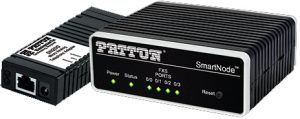What's Wrong with Fax-over-IP?
“It won’t go through,” she says. The fax, she means. Most existing FAX machines don’t work, or don’t work well once you adopt IP Telephony, a.k.a Voice-over-Internet-Protocol (VoIP). So. . . why is that?
Facsimile, now more commonly known as FAX (or Fax or fax), was developed around 1970 to transmit copies of paper documents over telephone lines. Eventually, the ITU protocol T.30 became the industry standard for analog fax transmissions over the PSTN. The T.30 procedures were designed to compensate for the common (and expected) noise, dropouts, and fading characteristics of voice lines. It was never foolproof, yet it worked pretty well, most of the time. As with most “standards” vendor implementations varied widely, so reliability was never 100 percent.
Now comes the Internet Age, which means you now need a Fax-over-IP (FoIP) gateway—in addition to the fax machine—at each end of the connection. The gateway converts the old-fashioned T.30 analog fax signal into the new digital T.38 protocol stream, developed for faxing in real-time over a Voice-over-IP (VoIP) network using the (IETF RFC3261) Session Initiation Protocol (SIP).
How FoIP is Supposed to Work
The gateway connects to an analog fax machine by emulating an analog line. It converts analog T.30 fax signaling and image data into digital form, which is transported to the remote side over an IP connection using either Pulse Code Modulation (PCM) G.711 or the newer and more reliable T.38 protocol. The device on the remote side may be a FoIP-enabled T.38 fax machine or another gateway that converts the received IP data back to T.30 for transmission to the fax machine (as depicted in the diagram below).
Why your FoIP service doesn’t work
New challenges introduced by the IP revolution can cause a fax call to fail. Digital (packetized) fax data is still subject to network impairments as is Voice over -Internet Protocol (VoIP). Here is a list of IP network characteristics that can break your FAX-over-IP service. . .
- Dropped or delayed packets — caused by network congestion. When fax signaling data is lost in dropped packets, the fax call fails. When FAX signaling is delayed beyond the specified time-frame, the receiving fax terminal may terminate the call and the fax fails. Increased bandwidth, class of service, service level agreements, traffic shaping (queueing algorithms) are all techniques that can be employed to mitigate the packet-loss problem.
- Out-of-Sequence Packets — While email or web pages can resequence packets with little notice to the user, out-of-sequence fax packets can interrupt the required signaling and cause the fax call to drop.
- Synchronization loss — packetization can cause interruptions in the bitstream, leading to differing, out-of-synch timing/clock pulses between endpoint fax machines, and breaking the connection. A receiver-side, dynamically-managed, jitter buffer can often ameliorate the synch-loss issue.
- Glare (call collision) — Call setup procedures in the SIP protocol were not designed with fax transmission in mind. Fax machines don’t really understand the process of invitations and re-invitations that SIP prescribes. When both machines try to invite each other at the same time, the procedure breaks down and the call gets dropped. RFC 6913 offers a solution that adds a SIP fax media feature tag to the Contact header field of REGISTER messages.
- Delay (signal timing) — Fax connections are extremely sensitive to network timing. If a packet containing fax signaling information is delayed somewhere along the way in the end-to-end connection, the fax machines may lose synchronization, causing call failure. One of the fax protocol timers may expire causing the call to drop. The use of a dynamically managed jitter buffer can help ameliorate this network impairment.
- Routing and Interoperability (network complexity) — There are hundreds of thousands of fax machines worldwide, implementing several different versions of the various fax protocols, including T.30, G.711, T.38—which do not interoperate. A FoIP connection may traverse multiple carrier networks, and not all service providers have implemented T.38, so protocol conversion may be required within the call path. A FoIP call involves two fax machines and two gateways, as well as access routers, all of which must interoperate for a fax transmission to successfully complete. Further, T.38 has been implemented with multiple variations among equipment vendors. So not all T.38 devices are compatible. So, you can see, with such a complex networking environment, there is a lot that can go wrong.
FAX over IP that Works
For reliable FoIP, two things are essential:

- a reliable VoIP gateway that supports T.38 fax on the WAN side and T.30 fax on the LAN side. Many VoIP gateways on the market today are cheap and unreliable. Do your homework to select a gateway with a longstanding reputation for high-quality, reliability, stability, and universal interoperability. I strongly suggest considering the SmartNode 200 ATA & VoIP Gateway from Patton Electronics.
- an experienced T.38 fax service provider with an end-to-end T.38 network. You’re going to need a service provider with deep experience and expertise implementing, supporting, and troubleshooting T.38 service. Ask the right questions before you sign up. Make sure the service provider employs routing rules that avoid carriers that are still using the G.711 voice codec instead of the T.38 protocol for fax transport. Ensure the provider knows how to optimize all the T.38 protocol parameters for maximum resilience against the problematic network characteristics and impairments described above. I urge you to check out babyTEL.
Patton and babyTEL have partnered to create the Patton Cloud-Fax service, leveraging Patton’s SmartNode SN200 Analog Telephone Adapter (ATA) & VoIP Gateway combined with babyTEL’s T.38 fax network service.
Learn more about the reliable, optionally encrypted, cloud-fax solution from Patton and babyTEL by clicking here.
Source: Patton - Khaled Tewfik









